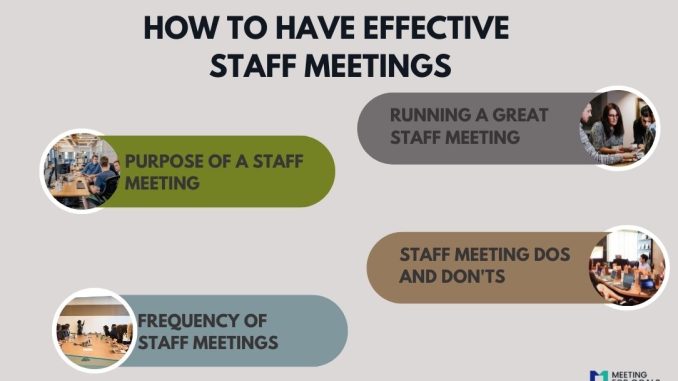
Team meetings are essential for fostering collaboration, aligning goals, and keeping everyone on the same page. However, all too often, meetings can become unproductive, overly long, or disorganized. If not executed properly, they can waste valuable time and leave team members feeling disengaged. As a leader, it’s crucial to ensure that team meetings are structured effectively to maximize their impact.
To help you run better, more productive meetings, here are some key strategies to consider:
1. Set Clear Objectives for Every Meeting
Before scheduling a meeting, ask yourself: What is the purpose of this meeting? Meetings without clear objectives often become unfocused, with conversations drifting off-topic. To avoid this, establish a clear agenda and ensure every participant knows the meeting’s goals.
-
Define the desired outcomes: Whether it’s to brainstorm ideas, solve a specific problem, or update the team on a project, know what you want to achieve.
-
Communicate the agenda: Share the agenda with all participants ahead of time so they can come prepared, especially if they need to gather information or do some prep work.
Having a well-defined purpose helps team members understand the value of attending and keeps discussions on track.
2. Invite Only the Necessary People
A common mistake in meetings is inviting too many people. The larger the group, the more difficult it becomes to maintain focus and ensure everyone is contributing meaningfully. As a leader, consider whether everyone on the invite list needs to attend.
-
Limit attendees to key decision-makers: Focus on people who can contribute directly to the agenda items.
-
Use optional attendees: If someone’s input might be useful but isn’t essential, mark them as optional so they can choose whether to attend based on their availability or interest.
By inviting only those who are necessary for the discussion, you can maintain a more streamlined and efficient meeting environment.
3. Stick to Time Limits
One of the biggest complaints about team meetings is that they drag on longer than necessary. People’s attention spans are limited, and lengthy meetings often result in disengagement and loss of productivity. Setting and adhering to time limits for each agenda item ensures that your meeting stays on track.
-
Set a meeting duration: A 30-minute to one-hour meeting is ideal for most discussions.
-
Use a timer: Consider using a timer to keep each topic within its allotted time. This helps prevent the discussion from going off course and ensures every point gets addressed without over-extending the meeting.
When participants know there’s a time limit, they tend to stay more focused and get to the point more quickly.
4. Encourage Participation from All Team Members
Meetings can sometimes become dominated by a few vocal individuals, leaving others with valuable insights too hesitant to speak up. As a leader, it’s important to encourage input from everyone on the team to foster collaboration and diverse perspectives.
-
Ask open-ended questions: Encourage input by asking questions that require more than a simple yes or no answer.
-
Incorporate round-robin formats: Give everyone an opportunity to share their thoughts on specific topics, which ensures equal participation.
-
Create a comfortable environment: Some team members may feel intimidated or shy about speaking up. Encourage a culture of open communication where all opinions are respected.
When everyone feels heard, it boosts morale and leads to more creative, well-rounded solutions.
5. Follow a Structured Agenda
Having a clear and organized agenda is key to running efficient meetings. Without an agenda, meetings can quickly become chaotic, with no clear direction and essential topics being skipped over. A structured agenda allows you to allocate time to each discussion point and helps participants stay focused.
-
Share the agenda in advance: This allows team members to prepare and come with ideas or information relevant to the topics.
-
Stick to the agenda: While it’s tempting to go off-topic, staying focused on the agenda ensures you cover all the necessary points within the allotted time.
-
Review the agenda at the start: At the beginning of the meeting, briefly review the agenda to set expectations and ensure everyone is aligned on what will be discussed.
A well-organized agenda gives the meeting structure and purpose, making it more effective.
6. Assign Action Items and Responsibilities
At the end of each meeting, it’s crucial to assign action items to team members. This ensures that everyone leaves with a clear understanding of what needs to be done and by when.
-
Be specific: Clearly outline what each action item entails, who is responsible, and the expected deadline.
-
Keep track of progress: Follow up on action items in future meetings to ensure accountability and keep projects moving forward.
Assigning clear action items helps team members stay on track and ensures that the meeting results in real progress, rather than just a discussion.
7. Follow Up After the Meeting
The work doesn’t end when the meeting concludes. To ensure that action items are completed and goals are achieved, follow up after the meeting.
-
Send meeting notes: Share the key takeaways and assigned tasks with the team as a reference.
-
Check in regularly: Hold people accountable by checking on the progress of action items before the next meeting. This helps keep everyone motivated and focused on their responsibilities.
A follow-up reinforces the importance of what was discussed and ensures things don’t slip through the cracks.
Conclusion
Effective team meetings are essential for collaboration, problem-solving, and decision-making. By setting clear objectives, inviting the right people, sticking to time limits, encouraging participation, and assigning actionable tasks, you can ensure that your meetings are productive and contribute to the success of your business.
Remember, the key to great meetings is not only to keep them focused and organized but also to foster an environment where all voices are heard and where action is taken. With these strategies, you can run meetings that drive progress and improve team performance.